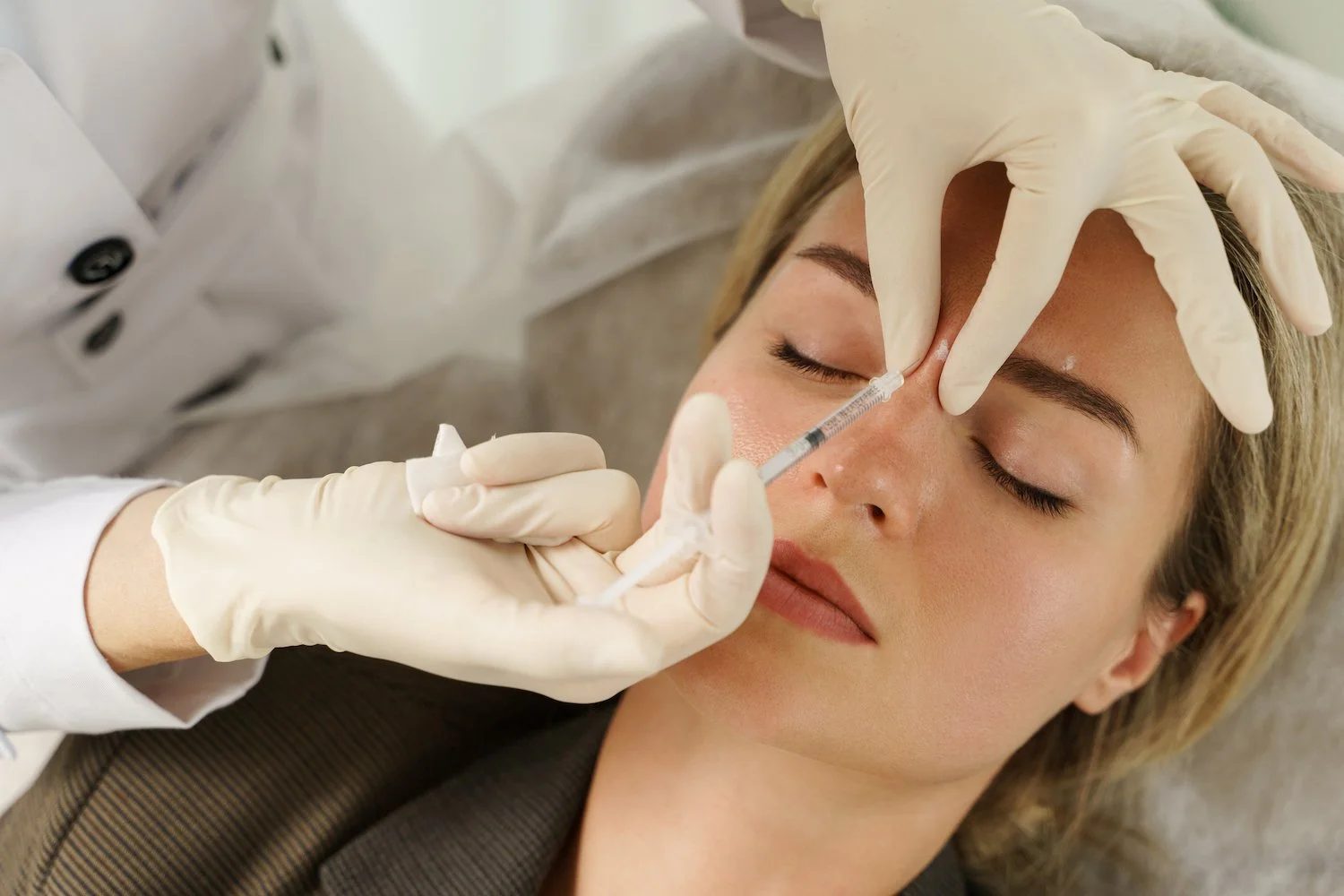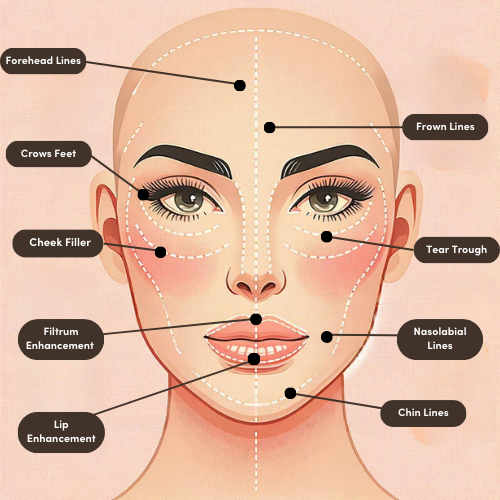How Long Does Dermal Filler Last?
For those looking to enhance their appearance with a non-surgical dermal filler treatment, the first question we are often asked at The Dental Spa is, 'How long does dermal filler last?'
The appeal of dermal fillers continues to surge, with a remarkable 4.3 million individuals worldwide opting for hyaluronic acid filler treatments in 2019 alone. Reflecting a shift in attitudes in the UK towards cosmetic enhancements, a Vice poll revealed that 59% of participants now see treatments such as lip fillers as routine beauty maintenance, on par with haircuts or manicures.
What Are Dermal Fillers?
Dermal fillers are a non-invasive cosmetic treatment used to restore volume, define contours and add fullness to the face. Among the various types of filler, hyaluronic acid fillers are particularly popular due to their compatibility with the human body and reversible nature.
Hyaluronic acid is a substance that's naturally present in your skin that helps to retain moisture and maintain plumpness. When used as a filler, hyaluronic acid is a gel-like substance that can be injected to smooth out wrinkles, define lips, and enhance facial contours. The results are immediate, providing a youthful appearance that blends seamlessly with your natural features. People also use dermal fillers to create fuller lips and lift and volumise cheeks.
How Long Do Dermal Fillers Last?
The duration of dermal fillers can vary, typically lasting between 6 to 18 months. However, the lifespan of hyaluronic acid dermal fillers isn't the same for everyone. Several factors can influence how long the results will last after your treatment.
The area where the filler is injected: Fillers in areas that move a lot, like the lips, might break down faster than fillers in less active areas, such as the cheeks.
Your body's metabolism: If you have a faster metabolism, your body might break down the filler more quickly. This is entirely individual and can vary significantly from person to person.
The type of hyaluronic acid filler used: Some are designed to be more robust and can withstand breaking down longer than others. Your practitioner will choose a filler appropriate for the treated area and your desired outcome.
How you care for your skin and overall health: Good skincare, including protection from the sun and a healthy lifestyle, can prolong the effects.
Understanding these factors can help you have realistic expectations about the duration of your dermal filler results and plan for future maintenance treatments.
Areas of Treatment
Hyaluronic acid dermal fillers are versatile and can be used in several areas of the face to enhance your features and reduce signs of ageing.
Lip Filler
One of the most popular treatment areas is the lips. You can achieve a fuller and more defined lip shape while also smoothing out the lines that often form around the mouth area. Given the frequent movement of the lips as we talk, eat, and express ourselves, the fillers in this region tend to have a shorter lifespan compared to other facial areas.
Cheek Filler
Dermal fillers can help to replenish the collagen lost due to ageing. Volume loss in the cheeks is a common concern as we age, leading to a less defined and sagging facial appearance. Cheek fillers are an excellent way to counteract this, giving your skin a smoother and plumper appearance and a lifted and youthful look. The results here generally last longer than those in the lips because the cheeks experience less movement.
Fine Line and Tear Trough Filler
The area under the eyes, known as the tear troughs, is prone to showing signs of fatigue and ageing, such as dark circles and fine lines. Fillers in this area can rejuvenate your appearance, creating a more rested and alert look. The procedure for under-eye fillers is delicate, necessitating an experienced practitioner due to the sensitivity and thinness of the skin in this region.
Each area requires a specific technique to achieve the best results for facial rejuvenation. Your practitioner will discuss the best options for you based on your facial structure and the improvements you wish to see.
Your Dermal Filler Appointment
When you decide to get hyaluronic acid dermal fillers, the process begins with a consultation. Here, you'll discuss your goals and concerns with your practitioner, and they will assess your facial structure and skin condition to recommend the best treatment plan for you.
On the day of the procedure, the practitioner will mark the areas on your face where the injections will be placed to ensure precision and symmetry. A numbing cream may be applied to minimise your discomfort during the treatment.
The actual injection process is very quick, typically taking no more than 30 minutes. Using a fine needle, the practitioner will inject the hyaluronic acid filler beneath the skin in the predetermined areas.
Aftercare and Maintenance of Filler Injections
After receiving hyaluronic acid dermal fillers, the aftercare is straightforward, but make sure it is followed properly to ensure good results and quick recovery.
Immediately after the procedure, it's advised to avoid strenuous exercise for 24 to 48 hours to minimise swelling and bruising. Also, it's best to avoid extreme heat, like saunas or sunbathing, as this can increase swelling.
Swelling and bruising can be managed with cold compresses, and you should avoid touching or massaging the treated areas unless your practitioner advises otherwise. This can help the filler settle properly and prevent it from moving to other areas.
Staying hydrated and maintaining a good skincare routine can support your skin's health, which can help extend the results of your fillers. Always apply sunscreen to protect the skin and the filler from the degrading effects of UV radiation.
Your practitioner may schedule a follow-up appointment to check the progress and make necessary adjustments. It's also a time to discuss any concerns or questions about your recovery.
Results and Expectations of Dermal Filler
When you get hyaluronic acid dermal fillers, you can expect to see results immediately. The fillers add volume and smooth out wrinkles as soon as they are injected. However, it's normal to have some swelling at first, so the initial appearance may not be the final result.
Over the next few weeks, as the swelling goes down, you'll be able to see the true effects of the fillers. This is also when you'll notice how the fillers settle into the skin, giving a more natural look. It's essential to have realistic expectations and understand that while fillers can make significant improvements, they are not a permanent solution.
The longevity of your dermal fillers will depend on the factors we discussed earlier, like the area treated, your metabolism, and the type of filler used. On average, you can expect hyaluronic acid fillers to last between 6 to 18 months. To maintain the look, you must plan for additional treatments before the filler fully metabolises.
Remember, each person's experience with dermal fillers can be different. Your practitioner will guide you on what to expect based on your individual circumstances.
Safety and Side Effects
Hyaluronic acid dermal fillers are widely considered safe, especially since hyaluronic acid is a substance naturally found in the body. However, like any cosmetic treatment, there are potential side effects and risks to be aware of.
Common side effects include redness, swelling, and bruising at the injection sites. These typically resolve on their own within a few days to a week. Applying ice and avoiding certain activities recommended by your practitioner can help minimise these effects.
The beauty of hyaluronic acid fillers lies in their versatility and safety, as they can be used in various areas of the face, including the cheeks, lips, and around the eyes. One of the benefits of dermal fillers is that they are not permanent, so if you're not happy with the results, they can be dissolved by a simple enzyme called hyaluronidase, making them a reversible option.
In the UK, dermal fillers are regulated to ensure they meet safety standards, and practitioners are expected to be adequately trained and licensed. It's essential to choose a reputable practitioner who is experienced in administering fillers and who can provide comprehensive information about the risks and benefits.
Discover your best self with The Dental Spa
If you're considering enhancing your features and seeking a refreshed look, our team of skilled professionals is dedicated to ensuring your comfort and satisfaction throughout the process. We understand that each individual's needs are unique, and we're here to provide personalised care tailored to your specific aesthetic goals. With our expertise in dermal fillers, we can help you achieve the natural and youthful appearance you desire. Don't wait to feel more confident in your skin – contact us now to book your consultation with The Dental Spa.
Dermal Filler FAQs
How long does cheek filler last?
The duration of cheek fillers can vary, but typically, the results can last anywhere from 12 to 18 months. This extended longevity is due to the slower metabolism of fillers in this less active facial region.
Are dermal fillers safe?
Dermal fillers are generally safe when administered by a qualified and experienced practitioner. Hyaluronic acid fillers are commonly used from substances similar to those found in your body, so they're typically well-tolerated. It's important to discuss your medical history and any allergies with your practitioner before the treatment.
Are injectable fillers permenant?
The reversibility of hyaluronic acid fillers is an important safety feature, as dermal fillers are not permanent. If you experience any issues or are unhappy with the results, an enzyme called hyaluronidase can be used to dissolve the filler quickly.
How long do dermal fillers take to settle?
Dermal fillers typically take about 1 to 2 weeks to settle into the treated area. During this time, any swelling and bruising will usually subside, and the filler will integrate with the natural tissue.


